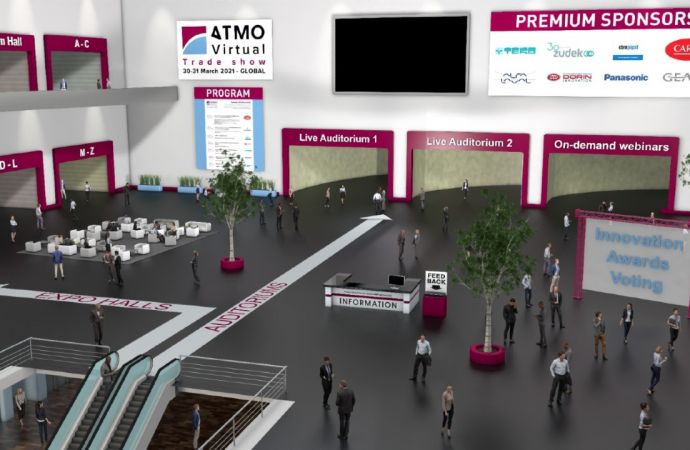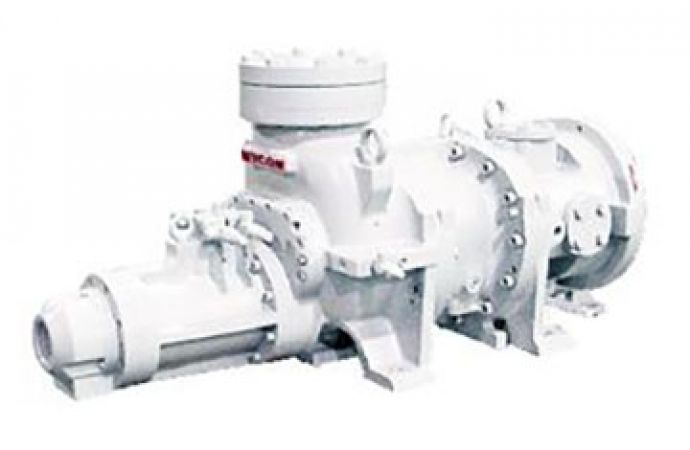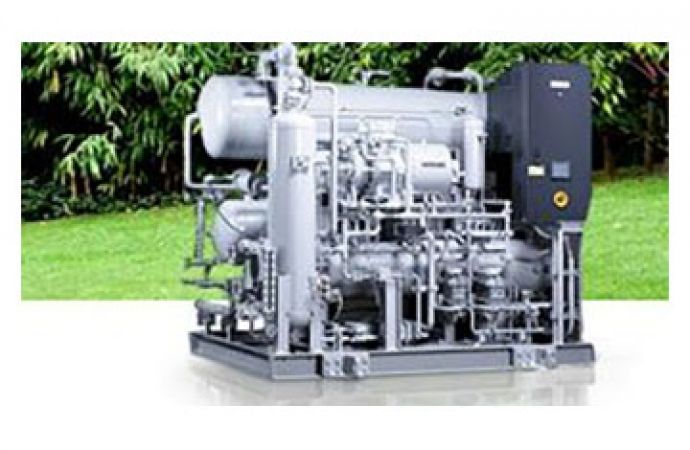At ATMOsphere Asia 2015 held in Tokyo from 3-4 February 2015, Mayekawa presented an overview of the government support available in Japan for natural refrigerant systems in industrial applications. End user, Kobeya Baking Company, shared the energy efficiency results of a converted R22 refrigeration system, which was replaced with a NewTon F600 NH3/CO2 solution. In a presentation by Mayekawa Australia Pty Ltd., ammonia heat pumps using rejected heat for hot water gener

End users switching their industrial refrigeration systems using R22 refrigerant to ammonia/CO2 systems is an expanding market worldwide. In Japan, this switch helped Kobeya Baking Company achieve 38% annual energy savings running at 90 kW as opposed to 130 kW. Yuji Nakajima, General Manager, discussed the company’s four main energy reduction initiatives implemented at the 7,034m2 frozen dough production facility, located in the Kanto area:
Four main energy reduction initiatives of the Kobeya Baking Company
In the future, Kobeya Baking Company plans to replace other R22 systems with ammonia/CO2 solutions in order to reach an end goal of 30% power consumption reduction. The company’s second priority is to introduce LED energy-saving lighting.
About Kobeya Baking Company
Founded in 1918 and headquartered in Osaka, Kobeya Baking Company employs over 1,400 workers and produces high quality breads, cakes and frozen dough. the Kobeya was the first company to use yeast for bread making - now an industry standard in Japan. The company mission is to develop a ‘food culture for the future’ through healthy and sustainable practices which include the elimination of harmful products such as emulsifiers and potassium bromide.
Update on natural refrigeration subsidies for cold storage in Japan
Kuniaki Kawamura, Mayekawa’s Executive Director, provided an update on industrial refrigeration systems using natural refrigerants in Japan. The Japanese Ministry of the Environment (MOE) is supporting natural refrigeration systems by providing subsidies which can help in areas such as food processing and freezing. Thirty refrigeration plants are already under construction using this support, and in 2015 around $60 million (€53 million) is expected to be granted in order to move the natural refrigeration market forward.
The NewTon 3000 refrigeration package for cold storage application uses mainly ammonia as the refrigerant and CO2 as the secondary refrigerant (brine). The NewTon can achieve up to a 34% energy reduction compared to existing R22 existing systems. There are 500 units currently running in cold storages and ice arenas in Japan. Through the JCM project (Joint Crediting Mechanism founded by the MOE Japan in 2013) for the cold chain industry, the NewTon package is now being installed in Indonesia, with plans to expand into Vietnam, India and Thialand.
Ammonia heat pumps using rejected heat for hot water generation in meat processing plants
Martin Millow, New Zealand Regional Manager at Mayekawa Australia Pty Ltd., presented a case study about ammonia heat pumps using rejected heat for hot water generation in meat processing plants.
Both ammonia heat pumps installed in New Zealand have been at meat processing plants with a high hot water demand for C.I.P functions, sterilisation and wash down. The water temperature requirement is 65°C, which made this the ideal application for the technology. In this instance, an average COP of 6.5 was achieved with a heating capacity of around 458.5 kW, and 65°C hot water at a flow rate up to 221 litres per minute. The payback period for this particular system was less than 3 years, making it a very interesting investment for the end user.
It is important to note the heat source temperature for the condensing temperature of the refrigeration system. At 25°C the capacity is 437.6 kW and it can achieve a 6.62 COP. At 30°C the capacity increases to 511.1 kW and it can achieve a COP of 7.67.
Refrigeration is key in most industries in New Zealand, specifically the dairy industry which represents 7% of the GDP. According to Mayekawa, it is estimated that the total heat of rejection from many of the New Zealand industrial plants can often exceed 2 MW, which is a large quantity of useful rejected heat available for recovery for hot water generation.
Ammonia heat pumps offer:
Four main energy reduction initiatives of the Kobeya Baking Company
- NH3/CO2 natural refrigerant system: the NewTon F600 90kW compressor replaced the R22 system, achieving 38% average annual power savings; an energy reduction of approx. 45% in the summer, and 25% in the winter.
- Inverter driven air compressor: the plant previously used a low-speed compressor which was less efficient in part-load conditions. The switch to an air driven inverter system achieved a 27% power savings and operates one set at 15 kW instead of two sets at 11 kW.
- Night time thermal storage: two electric heaters using only night-time electricity replaced a central steam boiler running on gas, which used to produce hot water 24 hours a day, which was unnecessary (remains the backup system only). A total savings of 75% in energy cost was achieved, in addition to other advantages such as mould elimination and securing personnel safety from steam burns.
- Roof with heat cutoff coating: spurred by the rise in summer temperatures in Japan, an increase of 5°C in August/ September from when the factory opened in 1996, a special roof was installed with a heat cutoff coating to prevent the heat from penetrating through the roof in the summer. The system has decreased the indoor temperature by 3°C, which is equivalent to reducing the cooling load by 25,000 kW per year, and also ensures product quality.
In the future, Kobeya Baking Company plans to replace other R22 systems with ammonia/CO2 solutions in order to reach an end goal of 30% power consumption reduction. The company’s second priority is to introduce LED energy-saving lighting.
About Kobeya Baking Company
Founded in 1918 and headquartered in Osaka, Kobeya Baking Company employs over 1,400 workers and produces high quality breads, cakes and frozen dough. the Kobeya was the first company to use yeast for bread making - now an industry standard in Japan. The company mission is to develop a ‘food culture for the future’ through healthy and sustainable practices which include the elimination of harmful products such as emulsifiers and potassium bromide.
Update on natural refrigeration subsidies for cold storage in Japan
Kuniaki Kawamura, Mayekawa’s Executive Director, provided an update on industrial refrigeration systems using natural refrigerants in Japan. The Japanese Ministry of the Environment (MOE) is supporting natural refrigeration systems by providing subsidies which can help in areas such as food processing and freezing. Thirty refrigeration plants are already under construction using this support, and in 2015 around $60 million (€53 million) is expected to be granted in order to move the natural refrigeration market forward.
The NewTon 3000 refrigeration package for cold storage application uses mainly ammonia as the refrigerant and CO2 as the secondary refrigerant (brine). The NewTon can achieve up to a 34% energy reduction compared to existing R22 existing systems. There are 500 units currently running in cold storages and ice arenas in Japan. Through the JCM project (Joint Crediting Mechanism founded by the MOE Japan in 2013) for the cold chain industry, the NewTon package is now being installed in Indonesia, with plans to expand into Vietnam, India and Thialand.
Ammonia heat pumps using rejected heat for hot water generation in meat processing plants
Martin Millow, New Zealand Regional Manager at Mayekawa Australia Pty Ltd., presented a case study about ammonia heat pumps using rejected heat for hot water generation in meat processing plants.
In New Zealand, there are are more than 600 Mayekawa industrial compressors operational; three NH3/CO2 cascade systems, which were installed within the last five years; and two 570 kW-h ammonia hot water heat pumps.Application examples have shown that ammonia heat pumps are effective in reducing annual energy consumption and CO2 emissions. The technology can significantly reduce the combustion and usage of water heating fuel sources such as natural gas and coal, to further assist the creation of a low carbon society,” said Millow. “Depending on system operating conditions and applications, a COP in excess of 8.0 is achievable.”
In the future we believe that ammonia heat pumps will compliment or replace conventional boilers because of their high efficiencies when providing hot water by utilising refrigeration rejected heat,” said Millow. “They not only reduce CO2 emissions, but they also offer a lower operational cost when compared to the traditional boiler applications.”
Both ammonia heat pumps installed in New Zealand have been at meat processing plants with a high hot water demand for C.I.P functions, sterilisation and wash down. The water temperature requirement is 65°C, which made this the ideal application for the technology. In this instance, an average COP of 6.5 was achieved with a heating capacity of around 458.5 kW, and 65°C hot water at a flow rate up to 221 litres per minute. The payback period for this particular system was less than 3 years, making it a very interesting investment for the end user.
It is important to note the heat source temperature for the condensing temperature of the refrigeration system. At 25°C the capacity is 437.6 kW and it can achieve a 6.62 COP. At 30°C the capacity increases to 511.1 kW and it can achieve a COP of 7.67.
If we consider the amount of heat rejected through condensers of industrial refrigeration systems globally, it’s a massive amount of energy being exported into the air – we need to start recovering some of this heat and using it,” said Millow. “Energy cost and demand is constantly increasing and natural resources are not going to be everlasting. Climate change is a key focus for us.”
Refrigeration is key in most industries in New Zealand, specifically the dairy industry which represents 7% of the GDP. According to Mayekawa, it is estimated that the total heat of rejection from many of the New Zealand industrial plants can often exceed 2 MW, which is a large quantity of useful rejected heat available for recovery for hot water generation.
Ammonia heat pumps offer:
- Continuous hot water supply
- Efficiency
- Relatively easy installation
- Environmentally friendly water heating (ODP = 0, GWP = 0)
- Variable supply hot water temperatures depending on the application
MORE INFORMATION
Related stories






